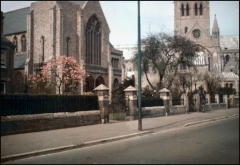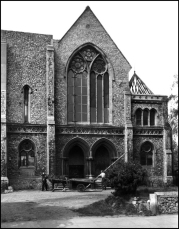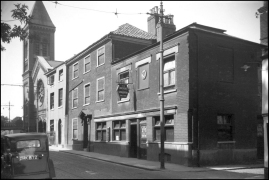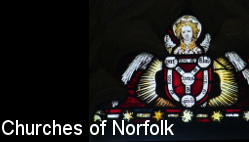| |
|
Trinity
URC, Norwich Immediately to the south of George Gilbert
Scott's great Catholic Cathedral of St John the Baptist
sits the most striking and memorable of all Norwich's
post-war churches, Trinity United Reformed Church. It was
built by Bernard Feilden, and opened for business in
1956. It is on the former site of Unthank Road Baptist
Church, which had been demolished for this purpose the
previous year. George Plunkett had taken an early colour
photograph of it shortly before the outbreak of the
Second World War, coming back in May 1954 to photograph
it again as it was prepared for demolition.
 
The light
brick of the church, and the green lantern of the tower,
are immediately reminscent of the 1938 City Hall further
down the hill, both buildings being derived from Swedish
influences, what is often refered to as the Stockholm
Town Hall school. Trinity moves ideas on, the body of the
church seeming to float above the lightly-enclosed plaza,
as though it was sitting in water. There are echoes of
this church in the more familiar work of Basil Spence in
the following decade. There is a great harmony between
the pointed angles of the church and the openness of the
plaza; although curiously, as Pevsner observes, the
square tower does not seem a participant.
| Of
course, the United Reformed Church was still
nearly twenty years away from existing when this
splendid church was opened, and it began life as
the Trinity Presbyterian Church. The congregation
had been founded in 1867, a period of expansion
for the denomination, and they built a fine
church in the Byzantine style in Theatre Street
in 1875. Like much of the St Stephen's area, it
was completely destroyed during the Norwich Blitz
of April 1942; George Plunkett took the
photograph of it on the right in 1936. The old
site was taken for street widening, and the
Unthank Road site nearby, although slightly
further out of town, was used for the
replacement. In 1972, the Presbyterian
church combined with large parts of the
Congregational movement to create the United
Reformed Church, which took its place as one of
the three main non-conformist denominations in
England. As with the Methodists and the Baptists,
this process of consolidation has led to the loss
of a number of older chapels, but Trinity
survives as one of the flagships of the URC in
Norwich today.
|
|
 |
|
|
|
